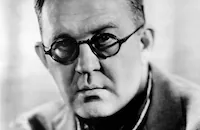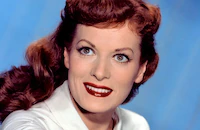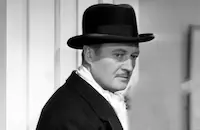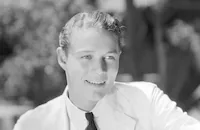The Wings of Eagles

Brief Synopsis
Cast & Crew
John Ford
John Wayne
Dan Dailey
Maureen O'hara
Ward Bond
Ken Curtis
Film Details
Technical Specs

Synopsis
In 1919 at the Pensacola, Florida naval base, spirited young officer Frank W. "Spig" Wead, one of pilots in the first Navy flying class, has been repeatedly denied permission to fly solo by his instructor Lt. Charles Dexter. A national rivalry between Army and Navy aeronautics divisions prompts Spig to accept Army pilot Capt. Herbert Allen Hazard's challenge to fly solo one day. Although Spig's daredevil flight in a seaplane with Hazard ends in a crash-landing at Admiral Moffett's tea party, Spig is cleared of all charges when he defends his actions as necessary to furthering Naval flight experimentation and bringing the `sea eagles' to the public's attention. When a drunk Spig returns home from celebrating the victory, his wife Minnie informs him that their son is ill.
After the toddler dies that evening, the alienated parents are unable to comfort each other, despite their shared grief. As time goes by, the couple happily rear two more children; however, Minnie is unable to cope with the frequent transfers necessary to Spig's career success. Their daughters are in elementary school when the Navy decides to compete with the Army in an aircraft race round the world and choose Spig to head their team. Although the race necessitates another move, Spig accepts the challenge, causing the couple to separate when Minnie refuses to move. Weeks later in Washington, Hazard and his Army team are celebrating the upcoming race at a nearby inn, when Spig and his crew interrupt the party, precipitating a fistfight. Unable to control the men, the manager shouts "police" and then directs the panicked servicemen toward the swimming pool, causing them to tumble into the water.
Soon after, Spig learns that Congress, concerned that the nation might disapprove of funding military competition, denies the Navy permission to enter the race. Needing to prove the team's abilities, Spig decides to enter the Schneider Cup international seaplane races, which he and teammate John Price win by shattering the seaplane endurance record. As he is about to accept a post as the youngest squadron commander in Navy history, Spig decides to reunite with Minnie and the children, who are living in Coronado. When he returns to the family home unannounced, he finds house littered with empty liquor bottles and his daughters unsupervised. The children, having only known him through naval newsreels, hardly recognize their father. When Minnie arrives home later in the evening, Spig expresses his regret about leaving the family. Minnie accepts his apologies and agrees to let him live with them again. After the couple spend a romantic evening together, a sleeping Spig awakens when one of the girls cries. Bolting out the bedroom door, Spig trips and falls down the stairs, cracking several cervical vertebrae.
Paralyzed from the neck down, Spig is hospitalized at the San Diego Naval Hospital. Held face down in traction with little hope of recovery, Spig breaks up with Minnie, hoping that she can make a new life for herself if she is not held responsible for his care. Minnie is heartbroken, but accepts Spig's wishes. The next morning, Navy mechanic "Jughead" Carson, who has been dispatched on special duty to aid in Spig's recovery, explains the invalid's physical limitations in terms of mechanics and then begins a daily routine of coaching Spig to send signals from his brain through his body despite the break in his spine. After several grueling months of repeating the phrase "I'm going to move that toe," the ebullient and devoted Carson places a mirror under Spig's down-turned face so that he can see his toes and then accompanies him on ukulele. By plying his reluctant body with alcohol and jokes, Spig is finally able to sit upright in his bed. One day he spots Minnie pacing outside the hospital and realizes that the roses Price regularly delivers are actually from his wife, who is still devoted to him.
Months later, Spig recovers the mobility of his hands enough to take up Carson's suggestion that he write down his tall tales. Finally Spig recovers his ability to walk, though haltingly and with the help of leg braces and two canes. Soon after his release from the hospital, the Navy, needing publicity to secure funding for new carriers, asks Spig to write military-related scripts for Hollywood and gives him an office with director John Dodge. After several years of collaborating on many military dramas, the two become close friends. Although the now-wealthy Spig is still officially married to Minnie, he resides alone in Hollywood. Years later, while in New York for the opening of his play Ceiling Zero on Broadway, Spig accidentally encounters Carson, who snubs Spig because he had not contacted since his recovery. Carson then suggests he make amends with Minnie and drives him to airport. Spig arrives at Minnie's San Francisco apartment unannounced and proposes that they form a family again. Minnie argues that she has a new life, but accepts his invitation to move to Hollywood.
After Spig returns home to prepare for Minnie's arrival, he hears the news that the Japanese have bombed Pearl Harbor. Driven by his patriotic duty, Spig reenters the service despite his disabilities. Unable to recognize and appreciate that Minnie loves him more than his comrades, Spig abandons his family one more time. Minnie accepts his decision as inevitable and encourages her "star spangled Spig." Spig is reunited with Carson and Price and throws himself tirelessly into strategizing for the Navy air carriers. He develops the idea of "jeep" carriers, small carriers which will furnish the big carriers with replacement planes when U.S. planes are downed by Kamikaze pilots. Given command of his own carrier near Kwajalein Island in the South Pacific, Spig witnesses the jeep carriers provide new planes to his ship within minutes of a Japanese attack. During one attack, Carson, realizing Spig is unable to move quickly enough to avoid the gunfire, protects his friend with his own body.
Later when Spig visits the wounded Carson, Carson tactfully rejects Spig's apology for his previous behavior and his offer of help. As Spig walks away from his friend, he suffers a heart attack and is consequently forced to retire from his post. With plans to return to Minnie and his girls, Spig is officially released from duty during a formal ceremony. Price and other soldiers aboard stand at attention in a tearful tribute, as Spig is transported in a chair lift off the carrier to an uncertain future.

Director

John Ford
Cast

John Wayne

Dan Dailey

Maureen O'hara

Ward Bond

Ken Curtis

Edmund Lowe

Kenneth Tobey

James Todd
Barry Kelley

Sig Ruman

Henry O'neill

Willis Bouchey

Dorothy Jordan
Peter Ortiz

Louis Jean Heydt
Tige Andrews
Dan Borzage
William Tracy

Harlan Warde
Jack Pennick

Bill Henry
William Ogden Joyce
Alberto Morin
Mimi Gibson
Evelyn Rudie
Charles Trowbridge

Mae Marsh
Olive Carey
Jody Mccrea
John Rosser
Ralph Volkie
Matt Moore
Edgar Washington
Web Overlander
Ray Baker
Michael Dugan

Veda Ann Borg
Danny Dowling

May Mcavoy
Russ Clark
William Forrest

James Flavin
Ruth Clifford
Marcoreta Hellman
Mabel Smaney
Caryl Lincoln
Audrey Betz
Eleanor Vogel
Jane Crowley
Janet Lake
Harry Strang
Ray Hyke
Crew
Jeff Alexander
Tom Andre
Jim Brock
Malcolm Brown
Frank Fenton
A. Arnold Gillespie
Keogh Gleason
Charles K. Hagedon
William Wister Haines
William A. Horning
Dr. John Keye
Dr. Wesley C. Miller
James E. Newcom
Warren Newcombe
Walter Plunkett
Adm. John Dale Price Usn (ret)
Gene Ruggiero
Charles Schnee
Wingate Smith
William Tuttle
Paul C. Vogel
Edwin B. Willis

Photo Collections
Videos
Movie Clip






Trailer
Hosted Intro
Promo
Film Details
Technical Specs

Articles
The Wings of Eagles
The Wings of Eagles is a biography of - and personal tribute to - Ford's longtime friend Frank "Spig" Wead. An ace flier in WWI and a pioneer of naval aviation between the wars, Wead was also a hard drinker and something of a rabble-rouser. His obsession with the military severely strained his home life to the point of causing a long separation with his wife (played by Maureen O'Hara) and their two baby girls. Eventually, they attempted to reconcile, but when an accident left Wead paralyzed from the neck down, he ordered his wife (at least in the film) to go live her life and not be held back by caring for him. Wead did, however, accept the help of longtime Navy buddy "Jughead" Carson (Dan Dailey), who forced him to rehabilitate - a highly dramatic sequence in the film that includes the memorable line, "I'm gonna move that toe!"
Wead regained the use of his limbs slowly - over three years. It was during this recovery time that he met John Ford, who was awed by his courage, principles and tenacity. (According to John Ford's biographer, Wead was one of the few men to whom Ford deferred.) Ford visited him in the hospital and encouraged him to put his military experiences down on paper. In time, Wead's fiction stories started getting published. Then came screenplays: he wrote several fine movies about the military starting in the early 1930s, including Dirigible (1931), The Citadel (1938), Dive Bomber (1941), Ceiling Zero (1936, based on his hit play) and Hell Divers (1931), a clip of which is shown in The Wings of Eagles. More notably, he wrote Airmail, directed by John Ford in 1932, and a decade later, Ford's They Were Expendable (1945) - one of the finest WWII films ever made. After Pearl Harbor, Wead convinced the Navy to call him back into active duty, and he devised the successful "baby carrier," a small aircraft carrier whose sole purpose was to re-equip larger carriers with planes as they were lost in combat. But his domestic life never recovered and he died a few years after the war. In fact, said Ford, "he died in my arms."
So when MGM approached Ford about a movie based on Wead's life, he was understandably reluctant. But once he did commit to direct it, he went about telling the story "as truthfully as possible." The script was based on Wead's own writings, and Ford said, "Everything in the picture was true. The fight in the club - throwing the cake - actually happened. I can verify that as an eyewitness. I ducked it. And the plane landing in the swimming pool right in the middle of the Admiral's tea - that really happened."
John Ford even appeared as a character in the movie, though in a slightly fictionalized form. Ward Bond plays a film director named John Dodge, modeled after Ford, who gives Wead his big Hollywood break. For film buffs, it's a total delight; Bond often mimicked Ford through their years of working together, and Ford allowed him to memorialize those antics here, in a performance that captures the gestures and arrogance of the legendary director, but in a loving way. It's an uncanny imitation. Bond even stole Ford's hat, pipe, Oscars and hollow cane for boozing, and put them all on the set of his character's office. He spoke Ford's own words on screenwriting to Wead: "I don't want a story just about ships and planes. I want it about the men who run them. How they live and think and talk. I want it from a pen dipped in salt water, not dry martinis." For the record, Ward Bond's character screens a clip of Hell Divers in this film even though Hell Divers was really directed by George Hill, not John Ford.
In many ways you can see why Ford was drawn to Wead. Ford also was obsessed by his work and had difficulty connecting to his family; perhaps that's a reason he was often attracted to characters whose obsessions made them unable to join normal society in some way. (The character of Ethan Edwards in The Searchers [1956] is another great example.)
As Wead, John Wayne is excellent. He's a difficult fellow to like, especially because he turns away from his wife and family so often, but the Duke's full, 3-dimensional performance movingly captures the frustrations and dreams of this tragic character. In a sign of his commitment to the role, Wayne even went without his toupee for sequences as the older Wead. He's still John Wayne, though... Look for him doing the dishes in one scene; no one ever made it look more manly.
Producer: James E. Newcom, Charles Schnee
Director: John Ford
Screenplay: Frank Fenton, William Wister Haines, Frank Wead
Cinematography: Paul Vogel
Film Editing: Gene Ruggiero
Art Direction: Malcolm Brown, William A. Horning
Music: Jeff Alexander, L. Wolfe Gilbert, Eliseo Grenet, Charles E. King
Cast: John Wayne (Frank 'Spig' Wead), Dan Dailey ('Jughead' Carson), Maureen O'Hara (Min Wead), Ward Bond (John Dodge), Ken Curtis (John Dale Price), Edmund Lowe (Adm. Moffett).
C-111m. Closed captioning. Descriptive Video.
by Jeremy Arnold

The Wings of Eagles
Kenneth Tobey (1917-2003)
Born in Oakland, California on March 23, 1917, Tobey originally intended to be a lawyer before a stint with the University of California Little Theater changed his mind. From there, he went straight to New York and spent nearly two years studying acting at the Neighborhood Playhouse, where his classmates included Gregory Peck, Eli Wallach and Tony Randall. Throughout the '40s, Tobey acted on Broadway and in stock before relocating to Hollywood. Once there, Tobey soon found himself playing a tough soldier in films like I Was a Male War Bride and Twelve O' Clock High (both 1949); or a tough police officer in Kiss Tomorrow Goodbye and Three Secrets (both 1950). Such roles were hardly surprising, given Tobey's craggy features, unsmiling countenance and rough voice.
Needless to say, no-nonsense, authority figures would be Tobey's calling for the remainder of his career; yet given the right role, he had the talent to make it memorable: the smart, likeable Captain Hendrey in The Thing From Another World (1951); the gallant Colonel Jack Evans in the "prehistoric dinosaur attacks an urban center" genre chiller The Beast from 20,000 Fathoms (1953, a must-see film for fans of special effects wizard, Ray Harryhausen; and as Bat Masterson, holding his own against Kirk Douglas and Burt Lancaster in Gunfight at the O.K. Corral (1957).
Television would also offer Tobey much work: he had his own action series as chopper pilot Chuck Martin in Whirlybirds (1957-59); and had a recurring role as Assistant District Attorney Alvin in Perry Mason (1957-66). He would also be kept busy with guest appearances in countless westerns (Gunsmoke, Bonanza, The Virginian) and cop shows (The Rockford Files, Barnaby Jones, Ironside) for the next two decades. Most amusingly, the tail end of Tobey's career saw some self-deprecating cameo spots in such contemporary shockers as The Howling (1981); Strange Invaders (1983) and his role reprisal of Captain Hendry in The Attack of the B-Movie Monsters (2002). Tobey is survived by a daughter, two stepchildren, and two grandchildren.
by Michael T. Toole
Kenneth Tobey (1917-2003)
Quotes
Trivia
Most of the extras in the Pensacola Florida scenes were actual Navy flight students and flight instructors. Although the Navy objected, director 'Ford, John' made certain that the military men were paid "extra" wages.
There is a scene in the movie where we see the director, played by Ward Bond, looking a clip of a film written by the main character. The clip is from the film Hell Divers (1931) which was actually written by Frank Wead.
Notes
The working title for this film was The Eagle Has Wings. In the opening credits, M-G-M acknowledged the support of the United States Department of Defense and Navy. This was followed by a written prologue: "This motion picture is dedicated to the men who brought Air Power to the United States Navy. One such man was Commander Frank "Spig" Wead. The flying records he smashed helped win him the lasting respect of his fellow Navy men. The screenplays he wrote helped win him the lasting respect of his fellow writers in Hollywood." Actor Ken Curtis, who portrayed "John Price," provided voice-over narration throughout the film.
Cmdr. Frank "Spig" Wead was one of the Navy's first pilots and a pioneer in air defense. When his military career abruptly ended as a result of being paralyzed in an accident, Wead turned to writing and completed several screenplays for M-G-M and other studios. John Ford directed several films that were based on Wead's writings, including Air Mail in 1932 and They Were Expendable in 1945 (see AFI Catalog of Feature Films, 1931-40 and 1941-50). A strong friendship developed during their collaborations. Wead wrote many other screenplays and/or stories that were adapted for the screen, including Dirigible directed by Frank Capra in 1931 and Ceiling Zero directed by Howard Hawks in 1936 (see AFI Catalog of Feature Films, 1941-50). In 1943, Wead returned to the Navy to serve in the South Pacific, where his battle plan won the Navy a victory in the Battle of the Marianas. According to modern sources, Wead returned from his duty in the Pacific to find that his wife had left him. A September 9, 1956 New York Times article states that Wead died in 1946 in Ford's arms, although he actually died in 1947.
The Wings of Eagles was based on a number of Wead's writings, including the short story "We Plaster the Japs." According to information found in M-G-M Collection at the USC Cinema-Television Library, the short story outlined Wead's return to military duty during World War II and was the basis for the film's portrayal of that period.
According to a August 16, 1955 Daily Variety article, Robert Taylor was originally considered for the lead, while Richard Thorpe was to direct. By October 1955 Hollywood Reporter reported that Dwight Brooks was being tested for a lead role; however, John Wayne was finally chosen to portray Wead under Ford's direction. According to Dan Ford, John Ford's grandson and biographer, M-G-M, wishing to fulfill an obligation to the Navy, agreed to make a dramatic film that would promote naval aviation. After M-G-M commissioned Frank Fenton and William Wister Haines to write the screenplay based on Wead's writings, they approached Ford to direct it. Ford was reluctant to make a film portraying a close friend; however, according to his grandson, he could not bear having anyone else directing it and finally accepted the job.
The Wings of Eagles marked the tenth time Ford and Wayne worked together. Ford, who rose to the rank of rear admiral in the Navy, was the basis for the character "John Dodge." According to the pressbook found in the production file on the film at the AMPAS library, Dr. John Keye, portrayed by Louis Jean Heydt, was a technical advisor on the film, as was John Dale Price. Both Keye and Price had served with Wead in the Navy and were among Wead's close friends. The film was shot on location at the Naval Air Station in Pensacola, FL and aboard the U.S.S. Philippine Sea off the coast of southern CA. The film was previewed aboard the U.S.S. Lexington on January 24, 1957. As noted in the Daily Variety review, scenes from the 1931 M-G-M film Hell Divers (see AFI Catalog of Feature Films, 1931-40), which was written by Wead, were used in the viewing of dailies scene in The Wings of Eagles. Modern sources note that actor Ward Bond, as the character "John Dodge," used Ford's own pipe, hat, cane and Academy Awards during the Hollywood scenes. Bond was another close friend and frequent actor in Ford's films.
According to a May 6, 1957 Los Angeles Times article, producer Charles Schnee received a special citation from the Southern California Motion Picture Council for his production of the film. Several modern sources claim that the film celebrates alcohol consumption and failed marital relationships; however, Dan Ford suggests in his biography of Ford that The Wings of Eagles was the most autobiographical of his grandfather's films, stating, "a compulsive worker, a man of great obsessions, fanatically devoted to naval aviation at the expense of everything else . . .Wead was incapable of any real home life."

Miscellaneous Notes
Released in United States February 1957
Released in United States Winter February 22, 1957
Released in United States February 17, 1990
Shown at American Museum of Moving Images, New York City February 17, 1990.
CinemaScope
Released in United States February 1957
Released in United States Winter February 22, 1957
Released in United States February 17, 1990 (Shown at American Museum of Moving Images, New York City February 17, 1990.)
















